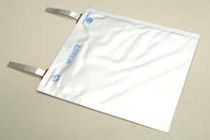Production technology development for the creation of a next-generation laminated lithium-ion battery
2012-0712-03

- researcher's name
-
about researcher OSAKA, Tetsuya Senior Research Professor (retired)
- affiliation
-
- research field
-
Device related chemistry,Nanobioscience,Electronic materials/Electric materials
- keyword
-
background
In order to promote energy conservation and renewable energies, which have seen a sudden increase in popularity since the Great East Japan Earthquake, there is an indispensable need for storage devices that can capture such energy. Among such devices, next-generation lithium-ion batteries possess high energy density and can be reused many times. They are widely used as small storage devices ranging from small-scale dispersed power sources to batteries for electric vehicles and mobile phones, with further applications continuing to be researched and developed. However, it is not easy to purchase small-scale production line batteries for use in research or at the starting stages of businesses. This poses barriers to research and development, new market entries, and the founding of start-up firms.
summary
This technology makes it possible to supply 50 to 1,000 mAh next-generation laminated lithium-ion batteries. The laminated cells are constructed under laboratory conditions within a dry-air environment (supplied air – dew point at <-95 Celsius, room dew point when non-operational at -70 Celsius). By making use of superior assembly devices and knowledge about next-generation lithium-ion battery development cultivated in a laboratory, it is possible to provide stable cells. In addition, as research-use cells, it is possible to disclose internal samples, and it is possible to provide cells on a custom order basis using any type of material and with the characteristics the recipient desires.
application/development
Based on this technology, it is possible to supply a variety of next-generation lithium-ion cells with varying capacities and characteristics according to the recipient’s desires and conditions.
predominance
As small-scale next-generation lithium ion-cell batteries for research use, it is possible to disclose internal samples and it is possible to provide cells on a custom order basis using any type of material and with the characteristics the recipient desires.
purpose of providing seeds
Sponsord research, Collaboration research, Technical consultation
material
same researcher's seeds
-
 Field Effect Transistor Sensor
Field Effect Transistor Sensor -
 Manufacturing of nano particle array substrates
Manufacturing of nano particle array substrates -
 Hard-gold film technology for the realization of low-resistance and high mechanical strength
Hard-gold film technology for the realization of low-resistance and high mechanical strength -
 All Wet ULSI manufacturing process
All Wet ULSI manufacturing process -
 Evaluating lithium-ion battery (LIB) cell degradation using an impedance measurement
Evaluating lithium-ion battery (LIB) cell degradation using an impedance measurement -
 Long-life negative silicon anode synthesis for next-generation lithium-ion batteries
Long-life negative silicon anode synthesis for next-generation lithium-ion batteries -
 Monitoring Chemical Balance in Epidermal Barriers
Monitoring Chemical Balance in Epidermal Barriers -
 Development of Biosensing Technology for Food Safety
Development of Biosensing Technology for Food Safety -
 Development of magnetic nanoparticles for cancer care
Development of magnetic nanoparticles for cancer care -
 Chemical Health Monitor Kind to Skin
Chemical Health Monitor Kind to Skin -
 Seeing mental stress from invisible substances
Seeing mental stress from invisible substances -
 Battery Diagnosis by Square-Current Electrochemical Impedance Spectroscopy
Battery Diagnosis by Square-Current Electrochemical Impedance Spectroscopy
posted:
2014/05/21

